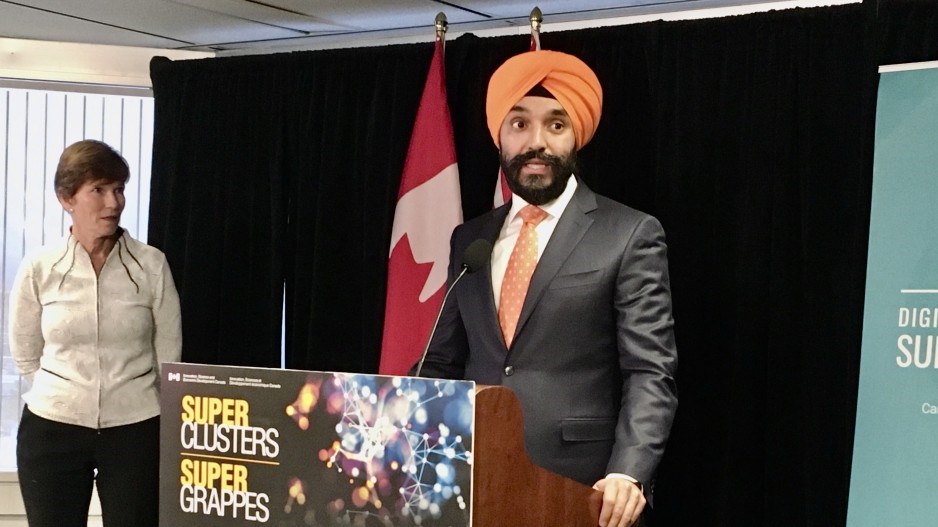What happened: Government and industry contribute multimillion-dollar sum to ignite collaborations between private sector, universities and non-profit institutions
Why it matters: The Digital Technology Supercluster estimates its efforts will create more than 13,500 jobs over the next decade
Industries as disparate as agriculture, augmented reality and genomics have at least one common thread going into 2020: big investment dollars from government and the private sector.
The Digital Technology Supercluster unveiled its second wave of projects in Vancouver on Thursday (January 16), with 16 initiatives ranging from fresh water monitoring to blockchain-backed health data now ready to tap into $25 million.
Ottawa committed $153 million to the Digital Technology Supercluster in November 2018, requiring participants to first make investments in collaborative projects pitched to the supercluster before receiving federal funding.
The goal is to stoke private industry and post-secondary collaborations on digital products that can be commercialized.
The Vancouver-based supercluster, which is open to organizations with a presence anywhere in Canada, estimates it will create more than 13,500 jobs and add more than $5 billion to the nation’s economy over the next decade.
Projects must include a minimum of three organizations, at least one of which must be a small- or medium-sized business.
This model has raised concerns that too much pressure is being placed on SMBs investing disproportionate resources compared with larger participants, such as Telus Corp. (TSX:T) or Microsoft Corp. (Nasdaq:MSFT).
“The vast majority of participants are small- and medium-sized businesses. The governance structure is designed to empower them in the decision-making process as well,” Innovation, Science and Industry Ministry Navdeep Bains told Business in Vancouver after announcing the second wave of projects.
“And they already benefit enormously from the mentorship, and the guidance and the leadership of working with some of the larger companies and potentially even being their customers and being part of that supply chain.”
The first wave of projects was announced in March 2019, drawing $40 million in investments — $25 million from the private sector and $15 million from government — to pursue products related to health care, natural resources and manufacturing.
“In the last 10 months the supercluster has gone from building its foundation to really accelerating into an environment where the projects that we announced last March are now starting to deliver results,” said Digital Technology Supercluster CEO Sue Paish.
“The projects that we have announced today have all been now fully contracted, and are launching or have already launched, and so they will start to deliver results in the next quarter.”
She added that those second-quarter results could range from indentifying the technology to hiring people to move a project forward.
“There’s really, I would say, magic that happens when people of different perspectives, with different experiences and different backgrounds come together and are prepared to listen to each other with the common goal of solving the big problem,” Paish said.
The 16 projects announced in this second wave include six technology-driven initiatives accounting for $20.4 million of the $25 million in announced funding.
The private sector and other partners are putting in $13.1 million into that pot, while the remaining $7.3 million is coming from Ottawa.
Another eight “capacity-building” projects — efforts to develop digital skills and talent within the workforce — will be getting $2.9 million from the private sector and other partners, $1.5 million from the province and at least $600,000 from the federal government.
Among the participants announced in the second wave of technology projects is Vancouver-based Terramera Inc.
The company recently raised US$45 million from investors as it pursues technology capable of significantly reducing the amount of chemicals used in agriculture over the next decade.
Terramera’s supercluster endeavour sees it collaborating with eight organizations, including Compression AI and Canada's Michael Smith Genome Sciences Centre, on the Precision Agriculture to Improve Crop Health project.
“Part of the value is to be able to see how other industries are solving similar problems,” Terramera CEO Karn Manhas told BIV.
“For us to have genomics facilities or all kinds of specialized facilities are quite costly, so to be able to partner with other organizations that can expand and extend our capabilities allows us to move much faster.”
The other supercluster technology initiatives announced Thursday were the Personal Health Wallet, Augmented Reality for Maintenance and Inspection, Fresh Water Data Commons, Intelligent Network for Point-of-Care Ultrasound and Reducing Opioid Use for Pain Management projects.




